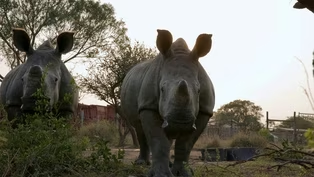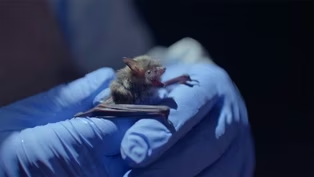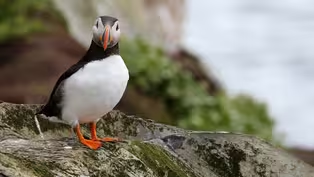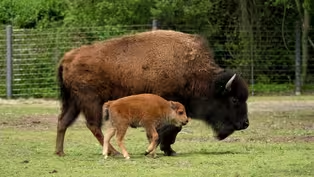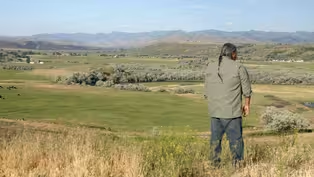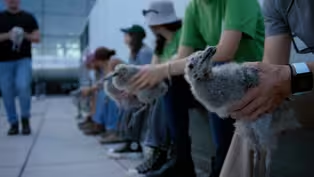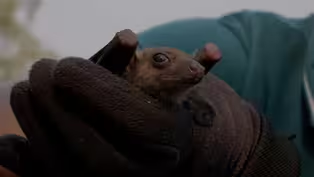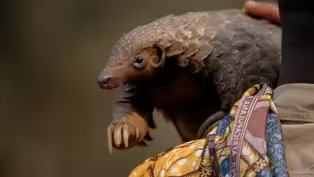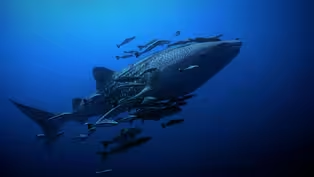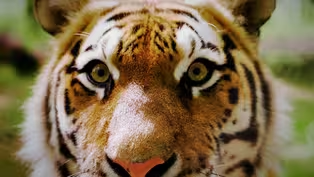
Mission Impossible | WILD HOPE
Special | 39m 41sVideo has Closed Captions
Meet the genius behind the plant-based Impossible Burger.
It was a late-career epiphany that led “wacky genius” Pat Brown to abandon his academic career and commit himself to fighting global warming and biodiversity collapse. He did it, against all odds, by developing a surprising product: the revolutionary and delicious plant-based Impossible Burger.
Problems playing video? | Closed Captioning Feedback
Problems playing video? | Closed Captioning Feedback
Major support for NATURE is provided by The Arnhold Family in memory of Henry and Clarisse Arnhold, Sue and Edgar Wachenheim III, The Fairweather Foundation, Charles Rosenblum, Kathy Chiao and...

Mission Impossible | WILD HOPE
Special | 39m 41sVideo has Closed Captions
It was a late-career epiphany that led “wacky genius” Pat Brown to abandon his academic career and commit himself to fighting global warming and biodiversity collapse. He did it, against all odds, by developing a surprising product: the revolutionary and delicious plant-based Impossible Burger.
Problems playing video? | Closed Captioning Feedback
How to Watch Nature
Nature is available to stream on pbs.org and the free PBS App, available on iPhone, Apple TV, Android TV, Android smartphones, Amazon Fire TV, Amazon Fire Tablet, Roku, Samsung Smart TV, and Vizio.
Buy Now
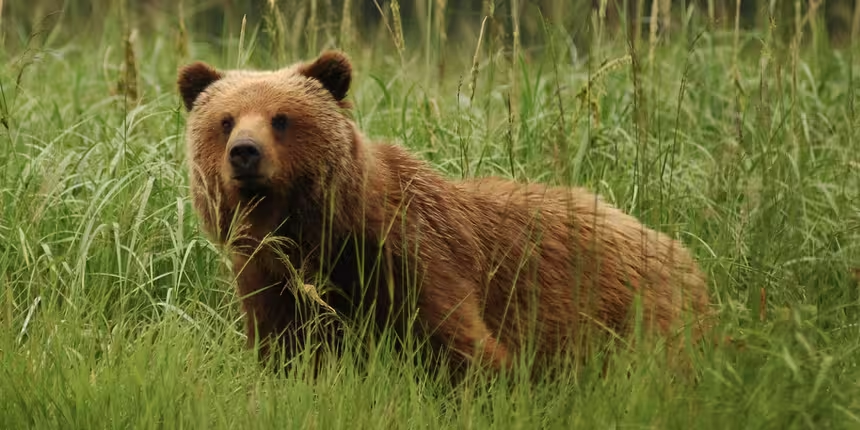
Explore More Ways to Watch
Bring the beauty and wonders of wildlife and natural history into your home with classic NATURE episodes.Providing Support for PBS.org
Learn Moreabout PBS online sponsorshipMore from This Collection
WILD HOPE is a new series of short films that highlights the intrepid changemakers who are restoring our wild places and sparking new hope for the future of our planet.
Video has Closed Captions
How does a densely populated nation like Singapore transform into a lush green oasis? (14m 51s)
Video has Closed Captions
For decades, rhinos have been the face of poaching. (16m 28s)
Video has Closed Captions
As a deadly fungus devastates North America’s bats, scientists are testing new ways to save them. (14m 47s)
Video has Closed Captions
In the Westman Islands, one community has banded together to save lost young puffins. (13m 15s)
Video has Closed Captions
Sixty million American bison once thundered across the prairies of North America. (18m 52s)
Reclaiming Bear River | WILD HOPE
Video has Closed Captions
The Bear River was once a lush area with wetlands, hot springs, and abundant wildlife. (17m 25s)
Building for Birds | WILD HOPE
Video has Closed Captions
Millions of migrating birds pass through our yards, but glass windows pose a deadly threat. (16m 3s)
Pangolin Protectors | WILD HOPE
Video has Closed Captions
Due to the demand for their scales, pangolins are the most trafficked animal in the world. (12m 24s)
Way of the Elephants | WILD HOPE
Video has Closed Captions
Elephant migration corridors in India are a necessary thoroughfare for one of the largest animals. (15m 11s)
Whale Shark Homecoming | WILD HOPE
Video has Closed Captions
A renowned spiritual leader is inspiring fishermen to become guardians of the world’s biggest fish. (16m 49s)
Video has Closed Captions
The artificial intelligence keeping tigers at bay. (14m 31s)
Providing Support for PBS.org
Learn Moreabout PBS online sponsorship(birds chirping) (train horn bellowing) PAT: I feel like one of the biggest problems that limits individuals is that they label themselves in a way that limits the possibilities - counting themselves out, because I'm not the right person for the job from the get-go.
And, I never do that.
♪ ♪ (footsteps) JOE: Pat Brown was an incredibly well-established, preeminent scientist at Stanford University biochemistry department and one of the best in the world.
DAN: The concept of him leaving all that was pretty shocking.
PAT: Which is the juiciest looking morsel here... Do not use this spoon.
SUE: He decided he wanted to work on something that was really of importance to the world.
PAT: The raccoons, and the squirrels, and the birds.
MARK: He thought about what's the most impactful question that he can pursue.
DAN: When Pat realized if we can replace animals in the food system, we can have a massive impact on the planet.
JOE: I heard that he wanted to start a plant-based meat company.
When I first heard about the idea I thought, that is nuts.
But if it's Pat Brown he might actually do it.
NARRATOR: This is the Impossible Burger.
ALLISON: So, do you think you're gonna be putting the conventional meat business out of business?
PAT: That's the whole purpose of Impossible Foods.
MARK: And now, his first step beyond Impossible Foods is to take over an animal farming ranch.
(laughs) What?
♪ MIKE: We are experts at turning forests into ranches.
We do not really know how to turn ranches into forests.
PAT: Of course, I'm not an expert on any of this, but it doesn't deter me because I feel like, okay, I'm not an expert.
Well, first of all, nobody else is an expert anyway.
And secondly, that's the most fun kind of project is one where, you know it's doable.
Okay.
Um, but you don't know how to do it.
And, uh, and that's, that's what this is all about here.
Yeah.
♪ (text whooshing) (graphic whirrs) ♪ (footsteps) NARRATOR: The long path that would eventually lead Pat to Arkansas began in the 1950s - a time when a few scientists were just beginning to raise concerns about greenhouse gases.
SCIENTIST: Even now, man may be unwittingly changing the world's climate through the waste products of his civilization.
Due to our release through factories and automobiles every year of more than six billion tons of carbon dioxide, our atmosphere seems to be getting warmer.
RICHARD C.: This is bad?
SCIENTIST: Well, it's been calculated a few degrees rise in the earth's temperature would melt the polar ice caps.
♪ NARRATOR: In those days, young Pat Brown was just beginning to explore the world around him.
PAT: My folks were so great.
They were so great.
♪ Both of them were incredibly curious and about the world and engaged in the world.
Both of them were in World War II.
And my mom didn't fight in any battles, being a woman in that era, but she was in the Marines.
My dad was in the army, and he was captured by the Germans and in a POW camp.
And weighed less than a hundred pounds when he got out.
I think partly because of the experience, he, um, joined the CIA.
So he worked for the CIA for his entire career.
I had six siblings.
I had four brothers and two sisters.
So, it was a big family.
RICHARD: Pat was number two.
I was number four.
I think the, the main thing was that we were free at a very early age to be in charge of what we're doing, unless we got in too much trouble.
Pat was probably the biggest troublemaker.
♪ PAT: In that era, especially if you had a big family, kids were very free range.
It's basically, you go out the door at some time in the morning, nobody asks, nobody notices.
And you come back hopefully alive, you know, at the end of the day.
♪ RICHARD: We moved quite a bit, Washington, Paris, Falls Church, Virginia, three years, lived in Taipei, Taiwan, four years.
PAT: My favorite game when I was in Taiwan, it was called British Bulldog.
♪ Basically, the game consists of, you have one person with like 25 boys trying to chase them down and tackle them.
I could've been a professional British Bulldog player, seriously.
Because I wasn't big, but- I was fast and, slippery and determined.
♪ I would say a very defining characteristic was curiosity.
I just really wanted to understand everything I encountered.
And I was particularly interested in the natural world.
♪ RICHARD: I remember Pat organizing events at the high school for the initial Earth Day.
Around the same time he was reading Euell Gibbons' "Stalking the Wild Asparagus."
EUELL: Ever eat a pine tree?
Many parts are edible.
RICHARD: And going out in the woods and looking for, uh, wild onions or things that might be edible.
EUELL: It's naturally sweet taste reminds me of wild hickory nuts.
PAT: A core feature of my parents is that you're expected to be devoting yourself to making the world better in some way.
And so I felt like, okay, an obvious thing to do was to go into medicine.
♪ SUE: Pat and I met when we were in graduate school at the University of Chicago.
I was in a PhD program in genetics, and he was an- an MD PhD student in biochemistry.
So we got to know each other.
We had a similar circle of friends.
MARK: He was a couple years ahead of me.
Already at that stage it was clear that he was super creative, super talented at the bench, super passionate about his, the, the research that he was doing and and extremely capable of, of, of, of doing that research.
NARRATOR: Trained as a pediatrician and a biochemist, Pat had a choice to make - medicine or science?
♪ He decided to accept a post-doctoral research fellowship studying viruses in the lab of future Nobel Prize winners Michael Bishop and Harold Varmus.
He and Sue moved to San Francisco.
It was 1985.
♪ (crowd clamoring) PAT: The AIDS epidemic was absolutely exploding in San Francisco.
It was clearly an important problem from a medical and public health perspective.
It was devastating for a lot of people in the city.
SUE: And it was just very sad, you know, and there was this awareness that there weren't drugs to treat AIDS.
PAT: I was working on trying to understand a fundamental part of how the HIV virus reproduces itself.
And nobody knew how that happened.
And so I said, okay, I'm gonna work on that.
I had an idea for how to get it to work in a test tube.
Because once you can do that, then you can start picking it apart in molecular detail.
If I told you some of the time I spent, you'd say that sounds like the most boring thing I could possibly imagine.
But when you're doing these really boring things, but the bigger picture is it's driving you, is, there's something exciting.
If you can get through it, you know, you're, it's fun and you're motivated.
Finally, after one year or as I had confirmed, this is exactly, no question, this had all the molecular hallmarks of a retrovirus insertion and basically now you can test for drugs that block this reaction.
DAN: Figuring out how HIV integrates early in his career, gave him that sort of self-belief that, you know, he could solve complicated problems.
And even if, you know, there are long stretches where things aren't working or you don't know how you're gonna get there.
NARRATOR: In the 1990s, Pat joined the biomedical faculty at Stanford University.
For the first time, he'd be putting together his own lab.
MARK: He could do anything he wanted.
Then he came up with this idea that transformed genomics.
NARRATOR: In those days, scientists were largely limited to studying genes one at a time.
PAT: A little inkwell.
NARRATOR: Then, Pat's lab invented the DNA microarray.
PAT: We realize that the microarrays could be used to look at the whole genome, all the genes in the genome.
NARRATOR: Pat's idea was to attach the DNA from thousands of genes to tiny spots on a microscope slide and then use florescent dyes to reveal which genes were active by lighting up the spots with different colors.
PAT: And this gives us a way to, whenever we look at a cell or a tissue sample, to recognize which genes are being used and how they are being used in a particular cell or tissue or process.
NARRATOR: The DNA microarray became a powerful tool in understanding the genetic origins and behaviors of certain cancers, including leukemia, lymphoma, and breast cancer.
MIKE: You know, the breakthrough was really just looking at the world and seeing a problem.
Saying, look, we can do this.
Let's just go into the lab for a year or two or whatever it takes and figure out how to do it right.
NARRATOR: Some years later, Pat became increasingly outraged at the high prices charged by established scientific journals.
So, along with Harold Varmus and Mike Eisen, he created a new one, free to everybody.
It's called the Public Library of Science, or PLOS.
JOE: His ability to start something up like the PLOS series of journals, I think really speaks to a subversive nature that is incredibly productive.
(clicks) NARRATOR: By 2009 Pat Brown was at the top of his profession.
PAT: I'd been at Stanford for, almost 25 years.
I absolutely loved my job.
And I never imagined really doing anything else.
And then I had my sabbatical.
What I wanted to do on the sabbatical, was to figure out what was the most important thing I could do to make the best possible world?
(chuckles) SUE: He decided he wanted to work on something that was really, really of importance to the Earth, to the world.
And he decided that global warming was it.
♪ (wind blowing) NARRATOR: Researching the causes of climate change, Pat started by studying the role of fossil fuels.
But soon, an unexpected culprit caught his eye.
PAT: I was looking at a bunch of sources and there was published evidence out there that animal agriculture was a big problem for climate.
And there was very little awareness of this as a problem in the world.
NARRATOR: Calculating animal agriculture's part in greenhouse gas emissions means adding up each step of the process, - from clearing the land, which often involves burning carbon-rich forests - to growing and harvesting feed crops - to fattening and butchering the animals And as part of their digestion process cows release huge amounts of methane, a heat-trapping gas 28 times more potent than carbon dioxide.
(cows lowing) PAT: It was responsible for more greenhouse gas emissions than the entire transportation sector.
For every car, bus, train, plane, boat, on Earth combined.
Okay.
A major greenhouse gas emitter.
NARRATOR: But our demand for meat was fueling a crisis on the ground that alarmed Pat even more.
PAT: When I started looking at biodiversity, then I realized, okay, that's probably an even worse problem due to a huge land footprint of animal agriculture.
NARRATOR: Of all the ice-free land on Earth, the estimated amount used to raise animals for food is 40%.
♪ PAT: And this is at the expense of the biodiverse ecosystems that live there.
The total number of wild mammals, birds, reptiles, amphibians, and fish living on Earth, each of them is less than a third what it was 50 years ago.
If that doesn't, like, send a chill down your spine, you're, you're not paying attention.
NARRATOR: Comparing the relative biomass of all the mammals on Earth... scientists estimate the planet is made up of: humans?
36% livestock?
60% - mostly cows and all the other 5000 species of wild mammals combined?
Just 4% ♪ (scale clattering) ♪ DAN: We've basically replaced, um, wildlife with cows and pigs and chickens.
(chickens clucking) SUE: So, the more he researched it and realized that animal agriculture was terrible for the planet, he started thinking about how he might have an impact there, what he could do to change things.
PAT: My feeling was, the environmental impact of the animal ag industry was completely unacceptable, and no one was seriously trying to make it go away completely, okay.
And, um, so that's what I decided I was gonna do.
DAN: And so then, okay, he started thinking, telling people not to eat animals isn't gonna work.
What we need to do is find a more efficient technology to make meat.
That's sort of where it all clicked for him, I think.
PAT: I realized that the most important scientific challenge in the world is figuring out what makes meat taste like meat.
If you can figure out what makes meat taste like meat, and find the necessary components to deliver that, you basically save us from the two biggest threats the planet is facing.
And I was pretty confident that it would be possible to make cheaper, more delicious, healthier, vastly more sustainable meat directly from plants.
♪ NARRATOR: Pat began reaching out to experts.
One of those was Harold McGee.
♪ HAROLD: Pat thought of contacting me because beginning in the 1970s, I started writing about the, the science of cooking.
His idea was if he could find a way to make something that was as delicious and appealing as meat, but without the environmental costs, that would be a project worth doing.
So it was hugely ambitious, because how you gonna do that?
(chuckles) PAT: You need optimism to be a scientist because you don't know you're going in the right direction until you get there, basically.
It's much more interesting if you're doing something in science that everybody thinks is crazy.
You know, bring it on.
NARRATOR: Pat had a hunch that a single molecule might be key to unlocking the secret of meat's flavor.
PAT: Right from the start, I was interested in a red molecule called heme.
Heme is one of the most essential molecules for all forms of life.
Literally, I think you could say it's essential for all life on Earth.
It's what carries oxygen in your blood from your lungs to all the tissues.
It's what makes your blood red.
And it's what makes muscle red or pink and so forth.
Actually, I have a model of heme here.
This is what a heme molecule looks like.
These are oxygen atoms.
These are ni, blue is nitrogen, white is hydrogen, black is carbon.
Um, but it's a, it's a, it's kind of a beautiful molecule, I think just in its own right.
SUE: It's part of myoglobin, it's part of hemoglobin.
So when you think of blood and meat, you know, you think heme is, is really important.
PAT: Heme is also one of the best catalysts.
And a catalyst is a molecule that helps cause chemical reactions to happen.
People care about the color, but I suspected it was gonna be the critical catalyst for flavor, because first of all, it has a bloody taste.
And so, it's like screaming at you that one of the best catalysts in nature, is one of the most abundant molecules in meat.
And so, I thought, I bet heme is the key catalyst for meat flavor.
NARRATOR: At first, Pat was hoping to hand his idea off to someone more qualified to take it on.
SUE: The idea was to find someone who might carry out his work or who he could work with to carry out his ideas.
And then it got really complicated there with talks with lawyers and contracts and, you know, he didn't want that.
He just wanted it to happen.
And so, as he often feels, if he wants something to happen, he has to do it himself.
So he started looking into founding a company.
NARRATOR: Pat never returned from his sabbatical.
And his departure from Stanford shocked the scientific community.
JOE: When Pat left his lab he's an incredibly well-established, preeminent scientist at Stanford University biochemistry department, one of the best in the world.
One of the highest levels of scientific achievement one can attain.
DAN: You know, the concept of him leaving all that I think for almost everyone was pretty shocking.
MIKE: Of all the people, if you had told me 10 years earlier that Pat was gonna end up starting a company like that, I would've laughed at.
NARRATOR: Intent on raising enough cash to put together the kind of research team that could develop his ideas and take on the meat industry, (clicks) Pat started pitching his vision to venture capitalists in nearby Silicon Valley.
RACHEL: I mean, it is almost unheard of that in your late fifties, right?
You would walk over to Sandhill Road and you would give a presentation that you just whip outta your MacBook, right?
And you get funding, and at 57 years old, you start a company that just does not happen, right?
SUE: Blasting ahead.
That was one of Pat's mottos.
DAN: Blast ahead.
MARK: Blast ahead.
PAT: Blast ahead.
And it doesn't mean blow things up and so forth.
It just means whatever is in your way you go around it, you go through it, you go over it, you just keep blasting ahead.
You get knocked down, you blast ahead, you know?
♪ I don't know.
I just love that expression.
It, to me, it just conveys a lot of the joy and determination of being a scientist, yeah.
(clicks) NARRATOR: As a complete outsider, Pat was able to approach the food industry from a different angle.
MARK: This was another revolution that Pat was kind of planning out, which was the food technology revolution.
NARRATOR: And nothing grabs Silicon Valley investors' attention like the words technology revolution.
RACHEL: Pat learned that really fast.
Obviously, under Pat Brown, Impossible Foods raised more than $2 billion.
PAT: The critical thing to investors is, this is a, at the time, one and a half trillion dollar global market that's being served by a prehistoric technology that hasn't improved in millennia and is demonstrably one of the least efficient technologies on Earth.
JOE: He's applying his skills where he can on a problem he thinks is incredibly significant.
Making proteins by growing cows.
I mean, it's kind of an insane old technology that basically doesn't even work very well.
NARRATOR: An average cow will need to consume 25 pounds of feed to produce one pound of edible beef.
Studies show 75% of the agricultural land on Earth is committed to raising livestock and using new food technology to get all our calories and protein from plants, would free up land the size of North America and Brazil combined.
With funding pouring in, Pat decided to put heme to the test on America's most iconic meat product.
PAT: Why a burger?
Something very close to half of all beef produced in the US is sold as ground beef.
It was important just for, for business purposes, um, but also for kind of sending a shot across the bow of the animal-based food industry in a way.
NARRATOR: Juicy broiled hamburgers with just the right touch of charcoal flavor from the fire have become an American institution.
JOE: I recall Pat explaining to me that, you know, people like their hamburgers.
NARRATOR: Just the elegant aroma of that ground beef picking up added flavor from the fire is enough to give everybody the firm idea that it's time to eat.
JOE: And so if you really wanna affect that part of the food economy, you have to provide a product that's just as good, just as delicious, cooks the same way, smells the same way, but doesn't have the climate impact that growing protein from a cow does.
SUE: It has to handle like meat.
When you pick it up, it should feel like, like raw, raw beef.
HAROLD: And then you put it in the pan and you start to cook it and it had to change colors just the way a beef burger does.
And develop all those wonderful aromas.
JOE: That challenge is huge, but it's also all biochemistry.
♪ NARRATOR: While meat is loaded with heme, the same molecule is also present in plants.
Now the question became: Which plants would provide enough heme to begin his experiment?
Pat started doing research on legumes, like soybeans.
DAN: I do remember one time where I came into his office, I remember his shoes up on the desk, sort of like leaning back in his chair, reading some papers: What are you reading?
He's like, Oh, I'm reading about soy root nodules.
Okay, why?
(laughs) PAT: What I remembered was that they have a very high concentration of a protein called leghemoglobin.
And I think I remembered it because I always thought the name was really funny.
There was this old-school cartoon character called Foghorn Leghorn.
And every time I hear a leghemoglobin... FOGHORN: Hmm, I'd better play it cagey.
PAT: I kind of do a double take.
SUE: He has a great memory for things he's learned, and he's very good at putting things together.
He knew that root nodules were gonna be a good source of heme.
PAT: Two or three months after Impossible Food started, we were in southern Minnesota, in soybean country, with a friendly farmer, harvesting soybean root nodules.
ARIEL: Nodules are like little balls along the roots and they're pretty delicate, so there's not already something in place in the farming industry to take them off of the roots and keep them intact, but also get rid of the, the waste.
And that, they ended up using a street sweeper for.
They basically rigged it so that you could put plants and roots down a chute and then it would go through these rolling bristles and sort of brush off the nodules, but not bring the root with it.
So, you had a lot of dirt and a lot of nodules and slowly collected enough to take home and purify.
♪ (clicks) NARRATOR: Taste tests in the lab confirmed Pat's hunch.
Adding heme to plant- based materials gave them a meat-like taste.
HAROLD: And it took Pat thinking from the ground up.
And asking very basic questions about what meat is and how its flavors developed to realize that heme was actually crucial in the generation of the aromas that we love in beef and meats in general.
So right off the bat, he'd come up with something that the meat industry had never realized about what makes their product delicious.
NARRATOR: But how to make enough heme?
Street sweepers and soy nodules weren't going to do it.
PAT: We need to figure out how, how we can make it at a very massive scale and cheaply.
NARRATOR: Eventually, the team came up with a plan to insert the soy DNA into yeast cells.
The yeast could then be fermented to produce the massive amounts of heme needed to keep up with demand.
Genetically modified yeast is a common tool in the food industry, especially in the production of beer and wine.
Getting the taste right was one huge hurdle.
But there were many other challenges confronting the burger-making teams, and they all had to be faced simultaneously.
ARIEL: We were kind of reverse engineering the burger.
So, we thought of it in its different components, the soft connective tissue, the lean tissue, the flavor, the juice, basically, um, the adipose tissue - fat.
And then thought about how to best recreate each of those tissues, combine them, and then hopefully we'd have something that was like ground beef.
♪ SUE: So many aspects needed to be right.
So, you could imagine maybe, uh, somebody puts together a prototype of beef that looks just like beef.
Or you try to make it into a patty, and it just disintegrates when you cook it.
So those are some of the earlier issues.
RACHEL: When I first joined, in 2016, we had a product that, let's be very, very clear, it was really subpar.
It was this gluten-based wheat burger, right?
It would fall apart effectively, um, under almost any cooking circumstance.
PAT: You know, in the first month, we made patties just to get a sense of: How far are we from anything close to what we wanna make?
Well, really far, okay?
RACHEL: The product wasn't nearly the, the sort of consistency - didn't have the chew down that true meat lovers loved.
So, the team iterated and iterated.
ARIEL: I was, I think optimistically skeptical (laugh), because it really took a, a long time for it to turn into something viable.
Um, but it seemed like an amazing idea.
So, I think everyone was just putting a lot of faith behind the idea.
(clicks) That attitude is kind of what kept us propelling forward.
RACHEL: So by the fall of 2018, the scientists approached me and they were like.
Hey, we, we want you to try this product, unlike the 1.0 Wheat Burger, the 2.0 burger was made with soy, which has much better consistency.
And so the moment I tasted that, I was like, whoa, this is a huge opportunity.
And it was this mega hit right from the beginning.
NARRATOR: This is the Impossible Burger.
WOMAN: It doesn't taste like plant.
(interviewer laughing) INTERVIEWER: So it tastes like the real thing?
WOMAN: It does.
I'm spooked.
STU: Burger A is the Impossible Burger GLENN: That is insane!
STU: (laughing) Isn't that insane?
PAT G.: That's amazing!
STU: I'm shocked that both of you went with the wrong one.
PAT G. Oh my gosh!
GLENN: That is amazing!
We are anti-fake food.
We are anti-vegan stuff.
We both hate vegetables.
And for that to fool, and I'm a rancher!
RACHEL: Oh my God it was so much fun.
Especially the launch of Burger King.
♪ CNN ANCHOR: This is not an April Fools' joke.
Burger King announced Monday it would launch the Impossible Whopper, made with plant-based patties from Impossible Foods, this week.
PAT: Launching into Burger King was a huge deal for us.
RACHEL: It really put plant-based meat on the map.
It put Impossible Foods on the map.
PAT: I feel like we've proven this is gonna work.
NARRATOR: It had taken more than seven years of trial and error, but Pat's Impossible Lab had created a nutritious plant-based burger with zero cholesterol, that third party research estimates uses 96% less land, 87% less fresh water, and generates 89% fewer greenhouse gas emissions than burgers made from cows.
DAN: When Burger 2.0 came out and people could get it in their hands and cook with it, I think that was an inflection point for the whole food system and we'll look back and see that this is really what set everything in motion.
When I tasted that, well, I, you know, maybe one of the few times I've cried after eating something, you know, 'cause of seven years in the making.
And what he had done, and what he had given up to do this.
And, also the, you know, implications, how big a positive impact this could have.
♪ RACHEL: It doesn't require people to buy a new car or anything like that.
Every single human being gets three chances a day to do the right thing by way of the environment and to not eat beef, right?
That's why it's so powerful.
♪ (engine revs) PAT: Once something changes in my life it's almost immediately in the rear view mirror.
If you ask me where my head is at, you know, are you living in the moment or are you living in the past?
Or something like that, I'm always thinking about the future.
MARK: So I, I just love it, you know, that his first step beyond, his Impossible Foods kind of corporate role (chuckles).
His first step beyond that is to take over an animal farming ranch.
(laughs).
That's the first thing.
What?
NARRATOR: Pat's strategy for saving the planet has always had two fronts: overcoming our dependence on animal meat and rewilding rural landscapes.
This thousand-acre cattle ranch in western Arkansas was purchased by the non-profit Impossible Foundation.
For Pat and fellow scientist Mike Eisen, it's an experiment to turn back the clock on decades of ecological damage.
PAT: When you look around here, as it, as it exists right now, (insects chirping) uh, it's pretty, and it feels like, in a way, wow, we're out in nature.
You know?
In reality, this isn't nature at all, okay?
This is a very unnatural landscape because in order to create it, the land had to be cleared.
It was almost entirely forested, this area of Arkansas.
You're so used to thinking of, you know, uh, a cattle farm as sort of part of nature.
And it's, it's, it's the destruction of nature.
DON: I got a phone call from, from Pat and Mike expressing their interest on planting trees and, you know, getting a call from someone from California to do some work in Arkansas.
That kinda got my interest going.
PAT: I love this, the fact that it's such a long list of trees.
DON: It is a very long list.
Yes.
Diversity.
PAT: I know.
That's exciting.
DON: Excellent diversity.
It is.
I haven't met a lot of professors from Californian universities, so getting a totally different thought process and, and look at the land and how it's used, for me, has been, been very interesting.
MIKE: So this is higher density, and these are slightly lower density.
DON: Okay, so that's new, yeah.
MIKE: This is all gonna end up being hardwood.
DON: You know, I'm not aware of a project exactly like this in, in the Southeast, so we're, we're glad to be a part of it.
♪ (leaves rustling) MIKE: This is an experiment for us to show people how they can use their land in, in a new way then our product here is, is carbon and our product is biodiversity.
PAT: You know, people talk about, uh, fancy technology for carbon capture, like incredibly expensive machines that require a ton of energy to run that suck carbon outta the atmosphere and squirrel it away.
This is by far the best, most proven technology on Earth for capturing carbon, pulling carbon out of the atmosphere.
The underlying technology, you could say photosynthesis, um, has been perfected over more than 3 billion years.
It's been optimized.
Okay.
NARRATOR: Before the tree planting begins, Pat and Mike are documenting as much of the existing ecology as they can.
15 camera traps and 22 microphones are capturing the sounds and images of the animals living along the edges of the pastureland.
PAT: I'm seeing a, uh, bobcat.
We see quite a few of 'em around here walking through the dry creek.
A Great Blue Heron.
NARRATOR: These recordings will provide baseline data to measure how things change as the forest returns.
PAT: We know that the loss of that habitat is the biggest driver of population declines in terrestrial animal species.
We're hoping that as the ecosystem recovers the numbers and diversity of wild animals here will increase.
And, uh, we'll find out.
♪ (shoveling) ♪ (footsteps) This is the start.
This is kind of an epic moment for this project where, basically a forest with, you know, more than 300,000 trees, is gonna grow up over the next several years.
So, it'll be amazing to just watch how it all plays out.
Just watch it grow up.
See the biodiversity.
And, what we hope to learn is what's the best way to do this, because amazingly it's really not well known at all.
NARRATOR: One of the biggest unknowns is: in a world without cows, what happens to the people who currently raise livestock for a living - and who are a powerful part of the international economy?
PAT: These farmers, if you're telling them to stop raising cows, they wanna know, okay, how can I be sure I'm gonna make money and make money on a reasonable timescale.
And I've always felt like, okay, this is part of the problem that we, we have to solve.
(drone revs) (beeping) So, as part of this experiment, one of the things we wanna do is develop a playbook for the farmers and ranchers.
Not just how to manage the land, but how to connect to the carbon markets.
This is the LiDAR.
NARRATOR: Carbon markets exist, but in an imperfect form.
Pat and Mike are anticipating a time when the market improves and carbon is seen as a resource companies and governments will pay to conserve.
Using LiDAR equipped drones, they're calculating how much carbon the ranch is currently holding.
PAT: It's something we're gonna be tracking as a way of measuring how much carbon's being captured on, on the land.
I think that it could turn out that part of what makes the industry go away isn't just the competition from plant-based meat, but it's the competition from a better way to make a living.
DON: If the carbon market was to continue evolving and, and maybe the prices, uh, increased, it could have a huge impact on the, on the amount of acres that are planted in trees, uh, throughout the country.
♪ (shoveling) (camera beeping and snapping) ♪ MIKE: The motivation for Impossible Foods from the very beginning was to enable a different use of all of this land.
It wasn't about burgers per se, it was about the need to use the land we currently use to raise cattle to help address climate and biodiversity.
A hundred years ago the challenge was feeding people.
Now the challenge is, um, saving the planet from the brink of destruction.
PAT: It's not just we need to eventually solve this problem.
We need to, we need to solve it as fast as possible.
And I do have this kind of like hardcore science optimism that pretty much any scientific problem can be solved.
(footsteps) You just keep blasting ahead.
♪ (footsteps) ♪ ♪ ♪ ♪ ♪ ♪

- Science and Nature

Explore scientific discoveries on television's most acclaimed science documentary series.













Support for PBS provided by:
Major support for NATURE is provided by The Arnhold Family in memory of Henry and Clarisse Arnhold, Sue and Edgar Wachenheim III, The Fairweather Foundation, Charles Rosenblum, Kathy Chiao and...

